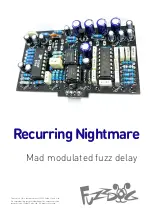
15
3.2
NUCLEIC ACID DETERMINATION
DNA, RNA and oligonucleotides can be measured directly in aqueous solutions in a diluted or
undiluted form. Aqueous buffers with low ion concentrations (e.g. TE buffer) are ideal for this method.
The concentration is commonly determined by measuring at 260nm against a blank and then
evaluating against a factor.
The 6850 has pre-defined methods installed which assume that absorption of 1 OD (A) is equivalent
to, approximately: 50 g/ml dsDNA, 37 g/ml ssDNA, 40 g/ml RNA and 30 g/ml for oligonucleotides.
DNA interference by contaminants can be assessed by the calculation of an absorption ratio. The
ratios A260/A280 and A260/A230 are used to estimate the purity of nucleic acids, since proteins
absorb at 280nm and substances such as peptides, phenols, aromatic compounds or carbohydrates
absorb at 230nm. Pure DNA should have an A260/A280 ratio of approximately 1.8 and pure RNA 2.0.
In pure nucleic acid samples the A260/A230 ratio should be approximately 2.2.
Nucleic acid concentration can also be estimated with the following calculations:
Conc ( g/ml) = (Abs@260nm x 62.9) – (Abs@280nm x 36.0)
Conc ( g/ml) = (Abs@260nm x 49.1) – (Abs@230nm x 3.48)
Referring to a blank value where no absorption should occur is commonly required. On the 6850 the
default reference wavelength is 320nm and the user can include the measured absorbance value in
all nucleic acid calculations. The default wavelength can be modified from 320nm if required.
3.3
SPECTROSCOPY MEASUREMENT
There are four main components of a spectrophotometer. These are a light source to emit a high and
constant amount of energy over the full wavelength range; a method for separating the light into
discreet wavelengths; a sample holder and a light detector.
The optical layout of the 6850 spectrophotometer is shown overleaf:
The light from the tungsten and deuterium lamps is focused onto the grating which separates the light
into discreet wavelengths. The diffracted spectrum of light then passes through a further slit and lens
arrangement before passing through a beam splitter which directs half of the light towards to sample
holder and half towards the reference sample holder. The light which is not absorbed by the two
solutions is transmitted through a collecting lens and onto the signal detector. The signal from each
photo-diode detector is used to calculate the % transmittance. The result is displayed either as %
transmittance or absorbance on the instrument display.
















































